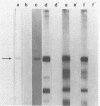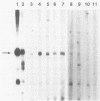Abstract
Genital warts (condylomata acuminata) are among the most frequent sexually transmitted infections. Human papillomavirus type 6 (HPV-6), which is etiologically related to a majority of these lesions, has not been propagated in tissue culture. We generated two forms of HPV-6 viral antigens: a chemically synthesized oligopeptide (referred to as the C-terminal synthetic peptide) corresponding to residues 482 to 495 of the 500-amino-acid-long L1 open reading frame (ORF), and a bacterially expressed 54-kilodalton (kDa) fusion protein containing the N-terminal 13 amino acids encoded by the lambda bacteriophage cII gene followed by one vector-insert junctional residue and 462 amino acids of the L1 ORF sequence (residues 39 to 500). The cII-L1 fusion protein was specifically recognized by an antipeptide serum directed against the N-terminal 13 amino acids derived from the cII gene, an antiserum raised against the C-terminal synthetic peptide, and a genus-specific serum prepared by immunization with disrupted viral capsids. The 54-kDa fusion protein was purified, and the sequence of its first 36 amino acids was determined and found to be as predicted by the DNA sequence. Both the genus-specific anticapsid serum and the antiserum raised against the fusion protein identified authentic L1 ORF proteins in HPV-1-induced (58 kDa) and HPV-6/11-induced (56 kDa) papillomas. The synthetic peptide antiserum recognized the 56- to 58-kDa protein in HPV-6-induced warts, but not in HPV-1- or HPV-11-infected specimens. Using the fusion protein as antigen in immunoassays, we were able to detect the corresponding antibodies in human sera.
Full text
PDF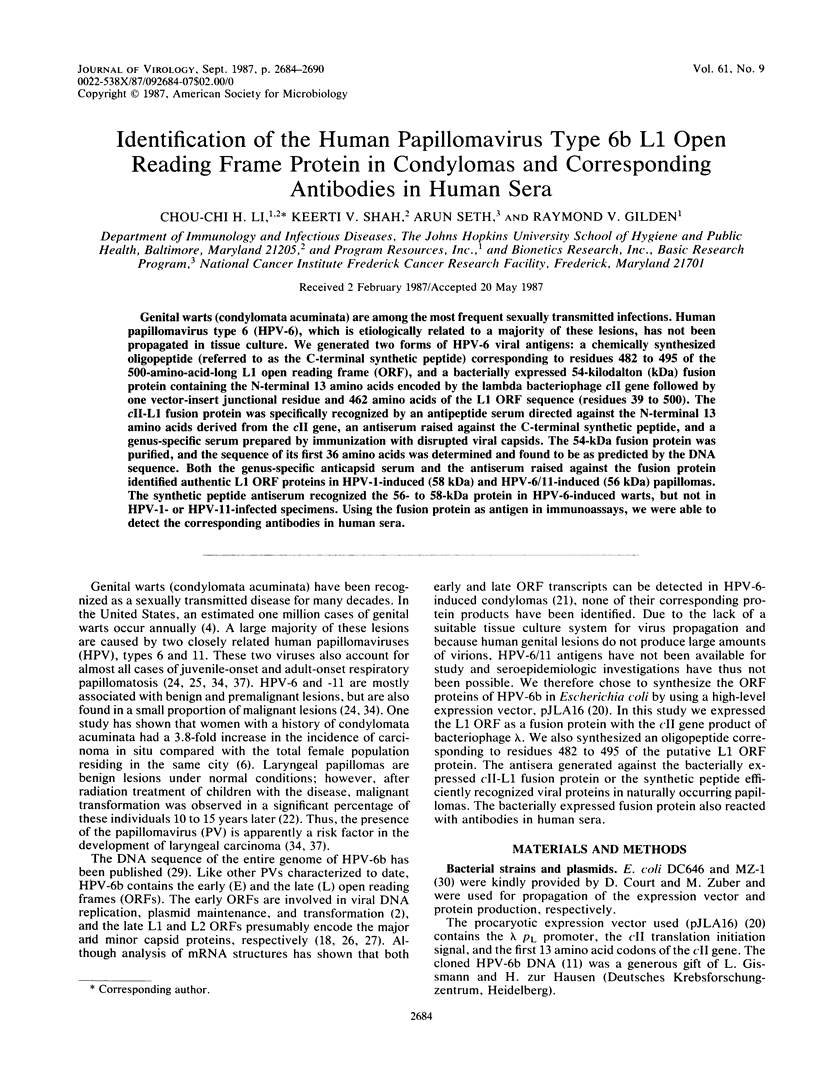
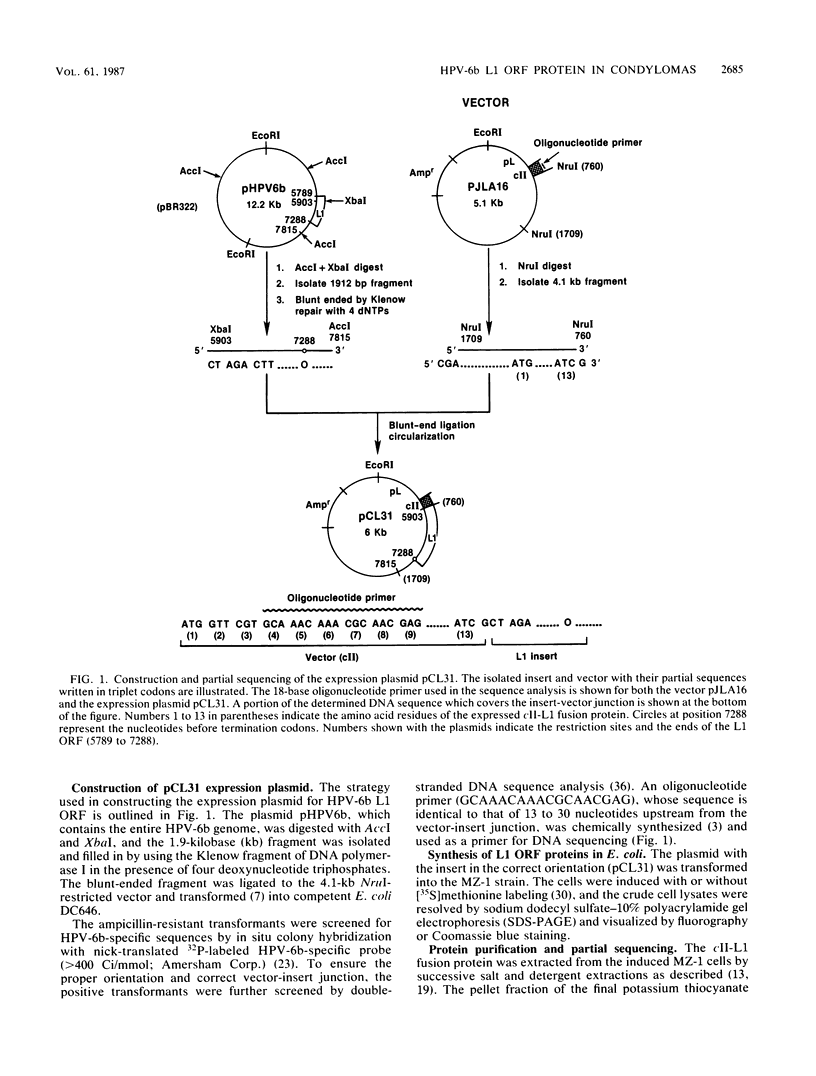
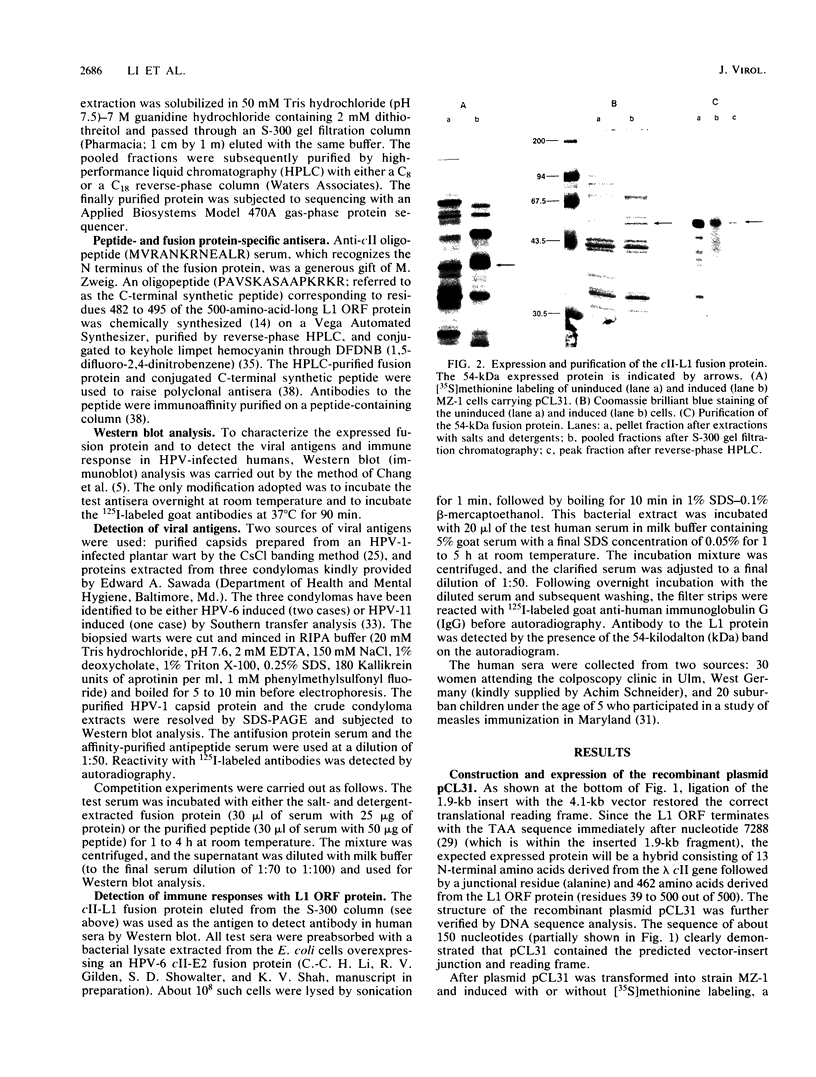
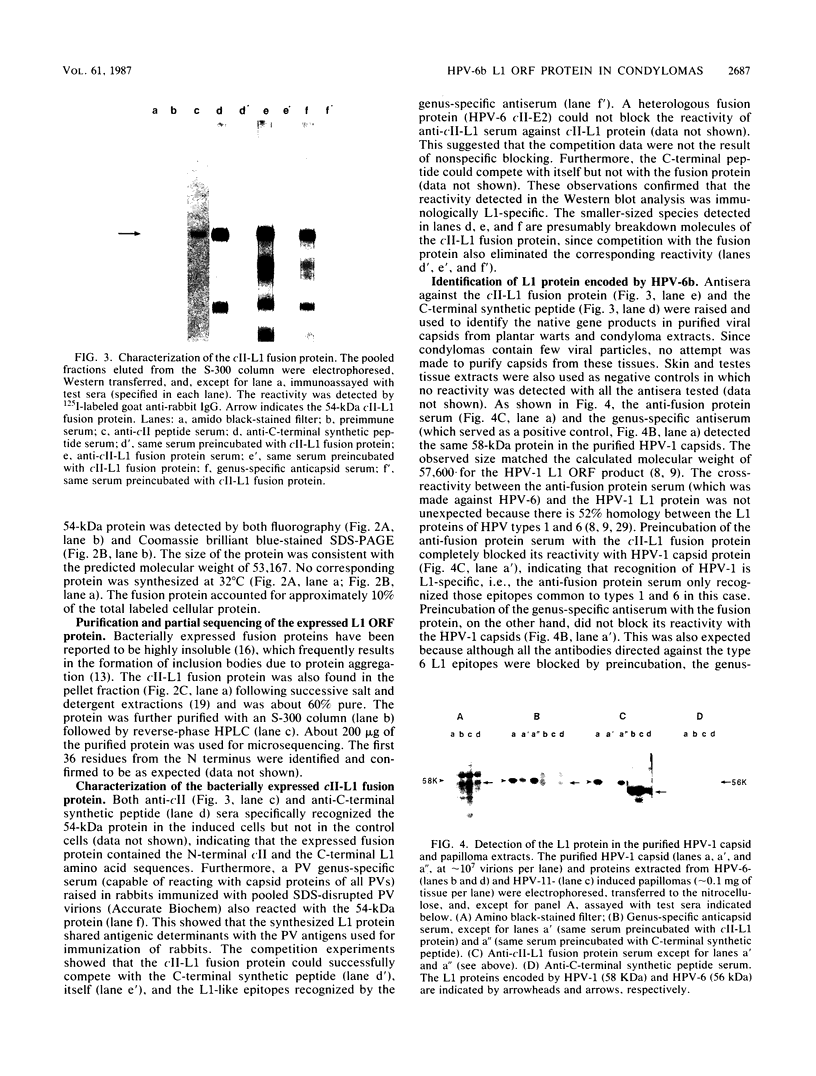
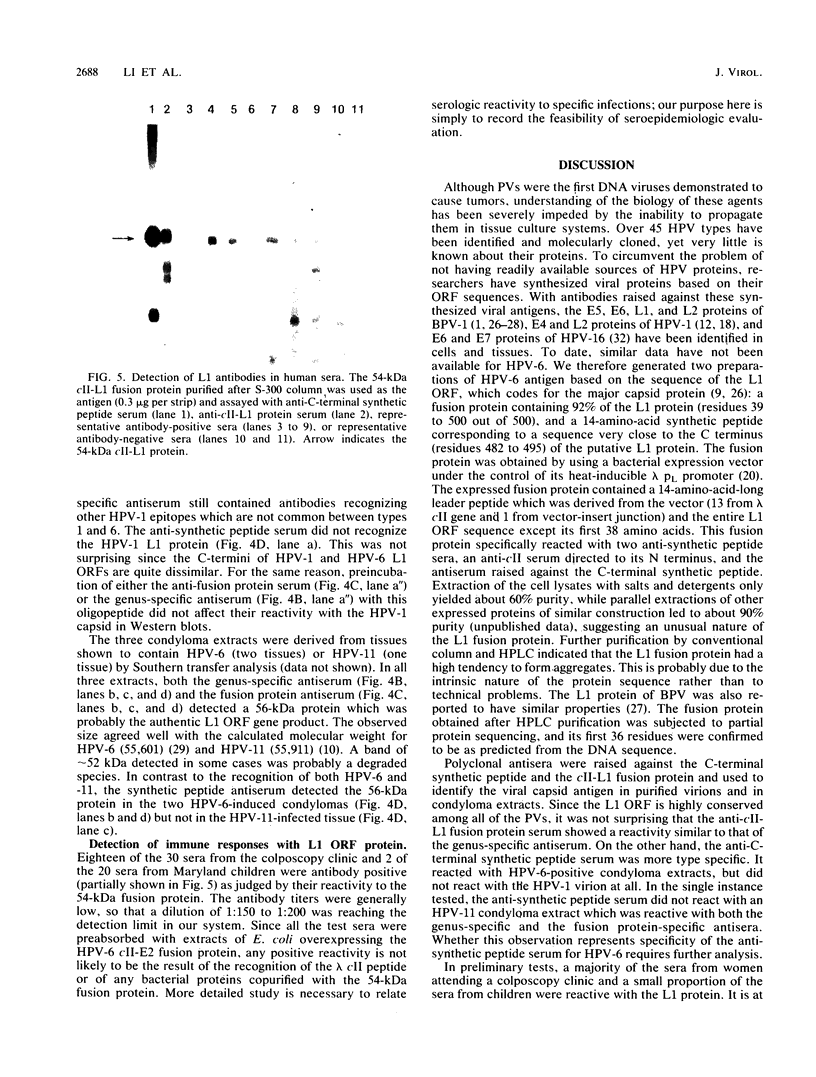
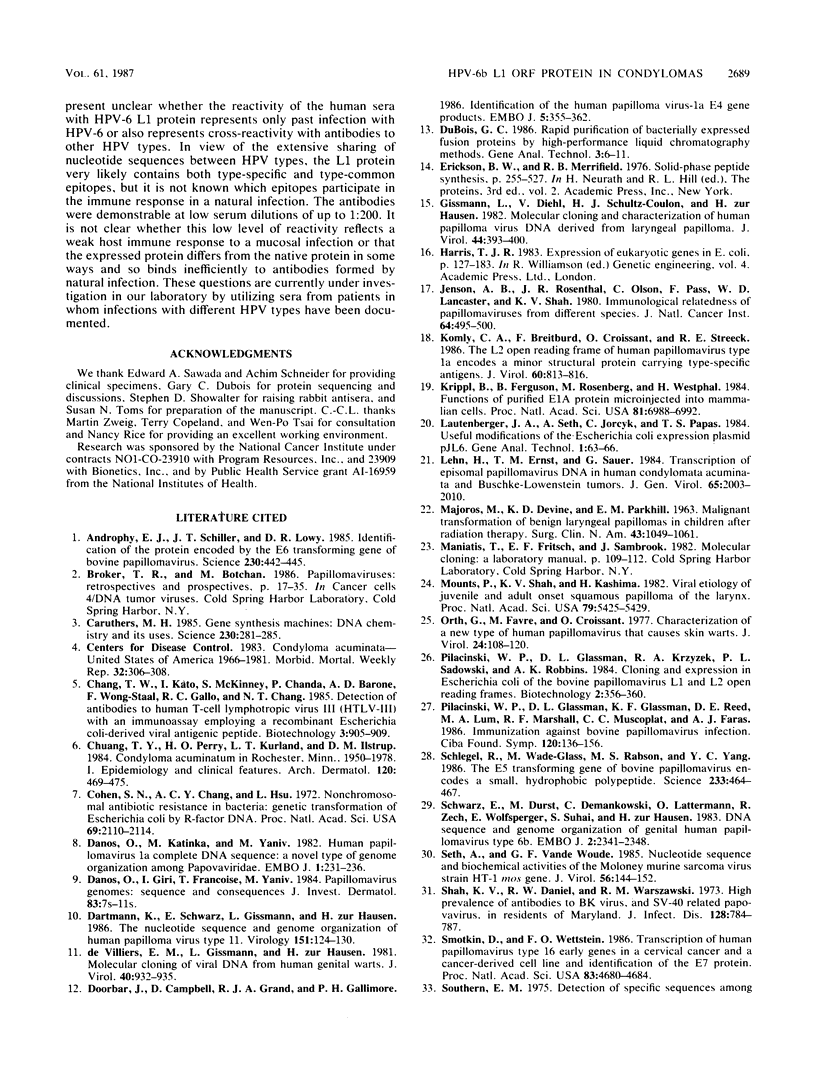

Images in this article
Selected References
These references are in PubMed. This may not be the complete list of references from this article.
- Androphy E. J., Schiller J. T., Lowy D. R. Identification of the protein encoded by the E6 transforming gene of bovine papillomavirus. Science. 1985 Oct 25;230(4724):442–445. doi: 10.1126/science.2996134. [DOI] [PubMed] [Google Scholar]
- Caruthers M. H. Gene synthesis machines: DNA chemistry and its uses. Science. 1985 Oct 18;230(4723):281–285. doi: 10.1126/science.3863253. [DOI] [PubMed] [Google Scholar]
- Centers for Disease Control (CDC) Condyloma acuminatum - United States, 1966-1981. MMWR Morb Mortal Wkly Rep. 1983 Jun 17;32(23):306–308. [PubMed] [Google Scholar]
- Chuang T. Y., Perry H. O., Kurland L. T., Ilstrup D. M. Condyloma acuminatum in Rochester, Minn., 1950-1978. I. Epidemiology and clinical features. Arch Dermatol. 1984 Apr;120(4):469–475. [PubMed] [Google Scholar]
- Cohen S. N., Chang A. C., Hsu L. Nonchromosomal antibiotic resistance in bacteria: genetic transformation of Escherichia coli by R-factor DNA. Proc Natl Acad Sci U S A. 1972 Aug;69(8):2110–2114. doi: 10.1073/pnas.69.8.2110. [DOI] [PMC free article] [PubMed] [Google Scholar]
- Danos O., Giri I., Thierry F., Yaniv M. Papillomavirus genomes: sequences and consequences. J Invest Dermatol. 1984 Jul;83(1 Suppl):7s–11s. doi: 10.1111/1523-1747.ep12281115. [DOI] [PubMed] [Google Scholar]
- Danos O., Katinka M., Yaniv M. Human papillomavirus 1a complete DNA sequence: a novel type of genome organization among papovaviridae. EMBO J. 1982;1(2):231–236. doi: 10.1002/j.1460-2075.1982.tb01152.x. [DOI] [PMC free article] [PubMed] [Google Scholar]
- Dartmann K., Schwarz E., Gissmann L., zur Hausen H. The nucleotide sequence and genome organization of human papilloma virus type 11. Virology. 1986 May;151(1):124–130. doi: 10.1016/0042-6822(86)90110-8. [DOI] [PubMed] [Google Scholar]
- Doorbar J., Campbell D., Grand R. J., Gallimore P. H. Identification of the human papilloma virus-1a E4 gene products. EMBO J. 1986 Feb;5(2):355–362. doi: 10.1002/j.1460-2075.1986.tb04219.x. [DOI] [PMC free article] [PubMed] [Google Scholar]
- Gissmann L., Diehl V., Schultz-Coulon H. J., zur Hausen H. Molecular cloning and characterization of human papilloma virus DNA derived from a laryngeal papilloma. J Virol. 1982 Oct;44(1):393–400. doi: 10.1128/jvi.44.1.393-400.1982. [DOI] [PMC free article] [PubMed] [Google Scholar]
- Jenson A. B., Rosenthal J. D., Olson C., Pass F., Lancaster W. D., Shah K. Immunologic relatedness of papillomaviruses from different species. J Natl Cancer Inst. 1980 Mar;64(3):495–500. [PubMed] [Google Scholar]
- Komly C. A., Breitburd F., Croissant O., Streeck R. E. The L2 open reading frame of human papillomavirus type 1a encodes a minor structural protein carrying type-specific antigens. J Virol. 1986 Nov;60(2):813–816. doi: 10.1128/jvi.60.2.813-816.1986. [DOI] [PMC free article] [PubMed] [Google Scholar]
- Krippl B., Ferguson B., Rosenberg M., Westphal H. Functions of purified E1A protein microinjected into mammalian cells. Proc Natl Acad Sci U S A. 1984 Nov;81(22):6988–6992. doi: 10.1073/pnas.81.22.6988. [DOI] [PMC free article] [PubMed] [Google Scholar]
- Lehn H., Ernst T. M., Sauer G. Transcription of episomal papillomavirus DNA in human condylomata acuminata and Buschke-Löwenstein tumours. J Gen Virol. 1984 Nov;65(Pt 11):2003–2010. doi: 10.1099/0022-1317-65-11-2003. [DOI] [PubMed] [Google Scholar]
- MAJOROS M., DEVINE K. D., PARKHILL E. M. MALIGNANT TRANSFORMATION OF BENIGN LARYNGEAL PAPILLOMAS IN CHILDREN AFTER RADIATION THERAPY. Surg Clin North Am. 1963 Aug;43:1049–1061. doi: 10.1016/s0039-6109(16)37041-4. [DOI] [PubMed] [Google Scholar]
- Mounts P., Shah K. V., Kashima H. Viral etiology of juvenile- and adult-onset squamous papilloma of the larynx. Proc Natl Acad Sci U S A. 1982 Sep;79(17):5425–5429. doi: 10.1073/pnas.79.17.5425. [DOI] [PMC free article] [PubMed] [Google Scholar]
- Orth G., Favre M., Croissant O. Characterization of a new type of human papillomavirus that causes skin warts. J Virol. 1977 Oct;24(1):108–120. doi: 10.1128/jvi.24.1.108-120.1977. [DOI] [PMC free article] [PubMed] [Google Scholar]
- Pilacinski W. P., Glassman D. L., Glassman K. F., Reed D. E., Lum M. A., Marshall R. F., Muscoplat C. C., Faras A. J. Immunization against bovine papillomavirus infection. Ciba Found Symp. 1986;120:136–156. doi: 10.1002/9780470513309.ch10. [DOI] [PubMed] [Google Scholar]
- Schlegel R., Wade-Glass M., Rabson M. S., Yang Y. C. The E5 transforming gene of bovine papillomavirus encodes a small, hydrophobic polypeptide. Science. 1986 Jul 25;233(4762):464–467. doi: 10.1126/science.3014660. [DOI] [PubMed] [Google Scholar]
- Schwarz E., Dürst M., Demankowski C., Lattermann O., Zech R., Wolfsperger E., Suhai S., zur Hausen H. DNA sequence and genome organization of genital human papillomavirus type 6b. EMBO J. 1983;2(12):2341–2348. doi: 10.1002/j.1460-2075.1983.tb01744.x. [DOI] [PMC free article] [PubMed] [Google Scholar]
- Seth A., Vande Woude G. F. Nucleotide sequence and biochemical activities of the Moloney murine sarcoma virus strain HT-1 mos gene. J Virol. 1985 Oct;56(1):144–152. doi: 10.1128/jvi.56.1.144-152.1985. [DOI] [PMC free article] [PubMed] [Google Scholar]
- Shah K. V., Daniel R. W., Warszawski R. M. High prevalence of antibodies to BK virus, an SV40-related papovavirus, in residents of Maryland. J Infect Dis. 1973 Dec;128(6):784–787. doi: 10.1093/infdis/128.6.784. [DOI] [PubMed] [Google Scholar]
- Smotkin D., Wettstein F. O. Transcription of human papillomavirus type 16 early genes in a cervical cancer and a cancer-derived cell line and identification of the E7 protein. Proc Natl Acad Sci U S A. 1986 Jul;83(13):4680–4684. doi: 10.1073/pnas.83.13.4680. [DOI] [PMC free article] [PubMed] [Google Scholar]
- Steinberg B. M., Abramson A. L. Laryngeal papillomas. Clin Dermatol. 1985 Oct-Dec;3(4):130–138. doi: 10.1016/0738-081x(85)90057-4. [DOI] [PubMed] [Google Scholar]
- Tager H. S. Coupling of peptides to albumin with difluorodinitrobenzene. Anal Biochem. 1976 Apr;71(2):367–375. [PubMed] [Google Scholar]
- Zweig M., Showalter S. D., Simms D. J., Hampar B. Antibodies to a synthetic oligopeptide that react with herpes simplex virus type 1 and 2 glycoprotein C. J Virol. 1984 Aug;51(2):430–436. doi: 10.1128/jvi.51.2.430-436.1984. [DOI] [PMC free article] [PubMed] [Google Scholar]
- de Villiers E. M., Gissmann L., zur Hausen H. Molecular cloning of viral DNA from human genital warts. J Virol. 1981 Dec;40(3):932–935. doi: 10.1128/jvi.40.3.932-935.1981. [DOI] [PMC free article] [PubMed] [Google Scholar]
- zur Hausen H. Human papillomaviruses and their possible role in squamous cell carcinomas. Curr Top Microbiol Immunol. 1977;78:1–30. doi: 10.1007/978-3-642-66800-5_1. [DOI] [PubMed] [Google Scholar]




